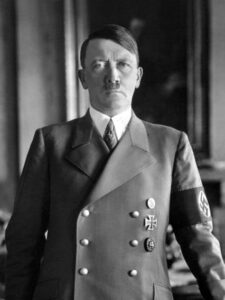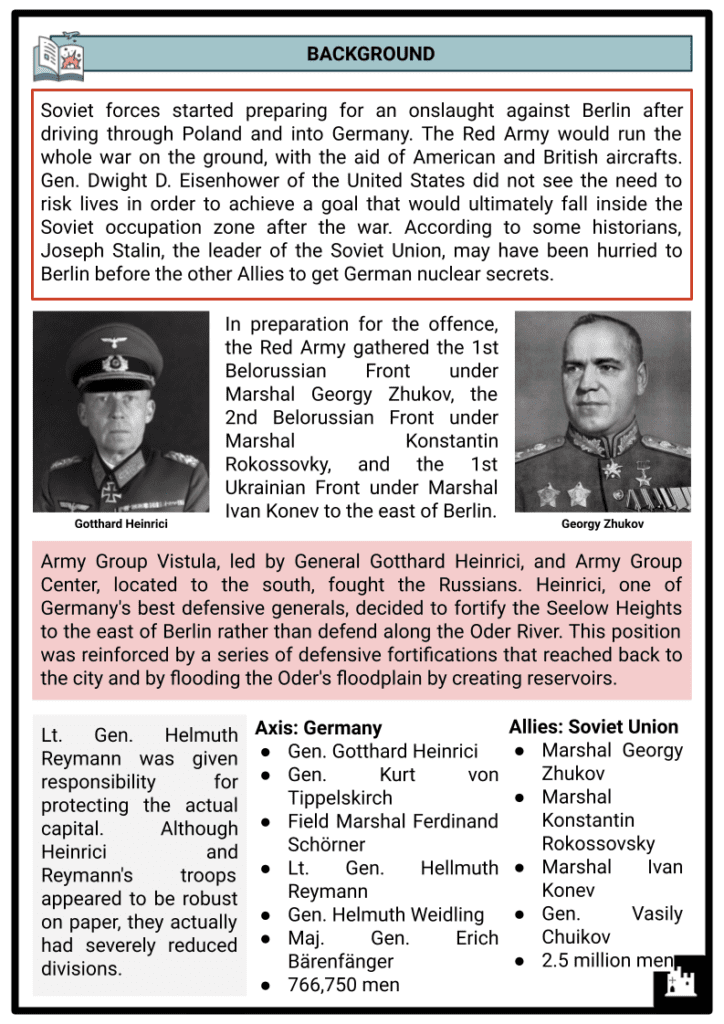Battle of Berlin Worksheets
Do you want to save dozens of hours in time? Get your evenings and weekends back? Be able to teach about Battle of Berlin to your students?
Our worksheet bundle includes a fact file and printable worksheets and student activities. Perfect for both the classroom and homeschooling!
Summary
- Background
- Course of the Battle
- Aftermath
Key Facts And Information
Let’s find out more about the Battle of Berlin (WWII)!

The Battle of Berlin, which took place from 16 April to 2 May 1945, was a pivotal and successful military action during World War II. It took place in Berlin, the capital of Germany, between the Soviet Union's Allied troops and the German Wehrmacht. In the end, Nazi Germany fell and the war in Europe was over thanks to this ferocious and persistent offensive. The Battle of Berlin marked a major shift in the European conflict. It marked the end of Nazi Germany and the start of a new period in European history.
BACKGROUND
- Soviet forces started preparing for an onslaught against Berlin after driving through Poland and into Germany. The Red Army would run the whole war on the ground, with the aid of American and British aircrafts. Gen. Dwight D. Eisenhower of the United States did not see the need to risk lives in order to achieve a goal that would ultimately fall inside the Soviet occupation zone after the war. According to some historians, Joseph Stalin, the leader of the Soviet Union, may have been hurried to Berlin before the other Allies to get German nuclear secrets.
- In preparation for the offence, the Red Army gathered the 1st Belorussian Front under Marshal Georgy Zhukov, the 2nd Belorussian Front under Marshal Konstantin Rokossovky, and the 1st Ukrainian Front under Marshal Ivan Konev to the east of Berlin.
- Army Group Vistula, led by General Gotthard Heinrici, and Army Group Center, located to the south, fought the Russians. Heinrici, one of Germany's best defensive generals, decided to fortify the Seelow Heights to the east of Berlin rather than defend along the Oder River. This position was reinforced by a series of defensive fortifications that reached back to the city and by flooding the Oder's floodplain by creating reservoirs.
- Lt. Gen. Helmuth Reymann was given responsibility for protecting the actual capital. Although Heinrici and Reymann's troops appeared to be robust on paper, they actually had severely reduced divisions.
Axis: Germany
- Gen. Gotthard Heinrici
- Gen. Kurt von Tippelskirch
- Field Marshal Ferdinand Schörner
- Lt. Gen. Hellmuth Reymann
- Gen. Helmuth Weidling
- Maj. Gen. Erich Bärenfänger
- 766,750 men
Allies: Soviet Union
- Marshal Georgy Zhukov
- Marshal Konstantin Rokossovsky
- Marshal Ivan Konev
- Gen. Vasily Chuikov
- 2.5 million men
COURSE OF THE BATTLE
- With the conquest of the Seelow Heights on 19 April, Soviet soldiers resumed their march into Berlin. The German defenders of the city put up fierce fight to Marshal Zhukov's forces and were prepared to use all means necessary to keep the city. The Soviet forces were heavily outnumbered during the assault on the Seelow Heights, yet they remained firm and committed to achieving their goal.
- Marshal Konev's forces seized Fort in the south and started to advance into uninhabited territory south of Berlin.
- By this manoeuvre, Konev was able to deploy part of his men northward into Berlin while sending others westward to join the approaching American forces.
- These developments almost engulfed the German 9th Army, essentially preventing them from sending reinforcements to Berlin.
- Under Marshal Zhukov's direction, the 1st Belorussian Front kept pushing into Berlin from the west.
- On 21 April, its artillery started bombarding the city, kicking off the decisive stage of the Battle of Berlin.
- The German defenders, who were well-entrenched in the city and prepared to fight to the death, put up furious opposition to the Soviet soldiers.
- The Soviet soldiers advanced, building by building and street by street, despite the Nazi resistance. There was fierce combat, and both sides suffered significant losses. Together with German forces, the Soviet troops had to deal with fervent Nazi sympathisers and citizens who were desperate to obstruct their approach.
- The 1st Ukrainian Front continued to advance south as Zhukov drove on the city. Konev forced the Army Group Centre's northern sector to retire towards Czechoslovakia by pushing it back.

Adolf Hitler - Adolf Hitler, the dictator of Germany, reached the depressing conclusion that the war was lost in Berlin. On 22 April, the 12th Army was given an order to move east in an effort to avert the crisis and join the 9th Army.
- The united army was thereafter supposed to help protect the city, according to the Germans. The 9th Army was completely encircled the next day, and the lead forces of the 12th were also engaged by Konev's front.
- Reymann was replaced by Gen. Helmuth Weidling when Hitler became dissatisfied with his performance. On 24 April, parts of the Zhukov and Konev fronts came together west of Berlin to completely envelop the city. They stabilised their position and started probing the city's defences. On 25 April, a portion of Konev's front came face to face with the American 1st Army at Torgau while Rokossovsky continued to push towards the north.
- Once Army Group Centre disengaged, Konev was confronted by the 9th Army, which was surrounded by Halbe, and the 12th Army, which was attempting to invade Berlin.
- The 9th Army sought to escape as the fighting went on, and about 25,000 of them managed to get to the lines of the 12th Army.
- Heinrici was supposed to be replaced by Gen. Kurt Student at the end of April. Gen. Kurt von Tippelskirch was granted command until Student could arrive (he never arrived).
- Gen. Walther Wenck's 12th Army, attacking from the northeast, made significant progress until being stopped at Lake Schwielow, 20 miles from the city.
- Wenck withdrew towards the Elbe and the American forces after being unable to advance and coming under attack.
- Weidling had around 45,000 warriors in Berlin, made up of the Wehrmacht, SS, Hitler Youth, and Volkssturm militia. Males between the ages of 16 and 60 who had not yet enlisted in the military made up the Volkssturm. It was created when the war was coming to an end. The Germans were not only greatly outnumbered, but also outclassed because many of their men had trained with them.
- On 23 April, the day before Berlin was encircled, the first Soviet attacks on the city started. Attacking from the southeast, they encountered fierce opposition but by the following evening had arrived close to the Teltow Canal and the Berlin S-Bahn train.
- On 26 April, the 8th Guards Army led by Lt. Gen. Vasily Chuikov marched from the south and assaulted Tempelhof Airport. The following day, numerous lines of Soviet soldiers were advancing towards the city from the south, southeast, and north.
- On 29 April, early, Soviet forces crossed the Moltke Bridge and launched assaults against the Interior Ministry. The absence of artillery assistance delayed these down.
- Later that day, after seizing the Gestapo headquarters, the Soviets advanced on the Reichstag. They attacked the famed structure the next day, and after several hours of bloody combat, they were successful in raising a flag above it.
- The Germans had to be thoroughly expelled from the building, which took an additional two days. Weidling warned Hitler that the defenders would soon run out of ammunition at their early 30 April meeting.
- Hitler gave the go-ahead for Weidling to try a breakout because he had no other choice. Hitler and Eva Braun, who were married on 29 April and refused to leave the city as the Russians closed in, waited in the Führerbunker until later that day, when they committed themselves.
- Grand Admiral Karl Doenitz took over as president after Hitler's death, and Joseph Goebbels, who was in Berlin, was named chancellor. On 1 May, the city's 10,000 surviving defenders were confined to a smaller area near the city centre. Although Goebbels wanted to keep up the struggle, Gen. Hans Krebs, Chief of the General Staff, began capitulation negotiations with Chuikov. When Goebbels committed suicide later in the day, this problem was resolved.
- While it was obvious how to surrender, Krebs decided to wait until the next morning so that an escape attempt might be made that evening. The Germans tried to flee in three separate ways going forward. Several people managed to reach American lines, but only those who made it via the Tiergarten were successful in breaching the Soviet lines.
- Soviet soldiers seized the Reich Chancellery early on 2 May. Weidling turned himself in with his crew at 6 a.m. When brought to Chuikov, he immediately gave the order for all surviving German soldiers in Berlin to submit.
AFTERMATH
- The world was affected significantly and permanently by the Battle of Berlin. The most immediate impact was the conclusion of World War II in Europe. Five days after Berlin fell, on 7 May 1945, Germany surrendered voluntarily. The conflict on the Eastern Front and in the rest of Europe was virtually ended by the battle.
- The Soviet Union, which sustained large losses during the assault on Berlin, felt the effects of the fight keenly. 81,116 Soviet soldiers were killed or went missing, while 280,251 were injured. The Soviet Union prevailed despite suffering significant losses, and the Battle of Berlin came to represent the Soviet Union's might and tenacity in battle.

Red Army soldiers celebrating the capture of Berlin - The effects on the city itself are also part of the Battle of Berlin's legacy. Following their conquest of Berlin, the Soviet soldiers made an effort to restore services and feed the citizens. Unfortunately, those Soviet soldiers that assaulted civilians and pillaged the city severely impeded these humanitarian relief operations. Even today, there remains debate over the Soviet Union's post-battle conduct in Berlin.
- The fight had a huge influence on Germany and its citizens as well. Both the Nazi government and the war came to an end with Berlin's collapse. With an estimated 125,000 civilian deaths throughout the war, the battle left a legacy of damage and devastation. The Battle of Berlin is still a potent representation of the high price of war and the sacrifices made by both military personnel and civilians.
- In summary, the Battle of Berlin was an important and successful military action that ended World War II in Europe. The outcome of the conflict had a huge impact on Germany, the Soviet Union, and the whole globe. The fight left behind a number of effects, including damage to Berlin, losses to the Soviet Union, and effects on Germany and its citizens. The Battle of Berlin is still a pivotal moment in world history and a constant reminder of the heavy price of war.
Image Sources
- https://en.wikipedia.org/wiki/Battle_of_Berlin#/media/File:%D0%91%D0%B5%D1%80%D0%BB%D0%B8%D0%BD%D1%81%D0%BA%D0%B0%D1%8F_%D0%BE%D0%BF%D0%B5%D1%80%D0%B0%D1%86%D0%B8%D1%8F.jpg
- https://en.wikipedia.org/wiki/Adolf_Hitler#/media/File:Hitler_portrait_crop.jpg
- https://en.wikipedia.org/wiki/Battle_of_Berlin#/media/File:Bundesarchiv_Bild_183-E0406-0022-018,_Berlin,_Siegesfeier_der_Roten_Armee.jpg






